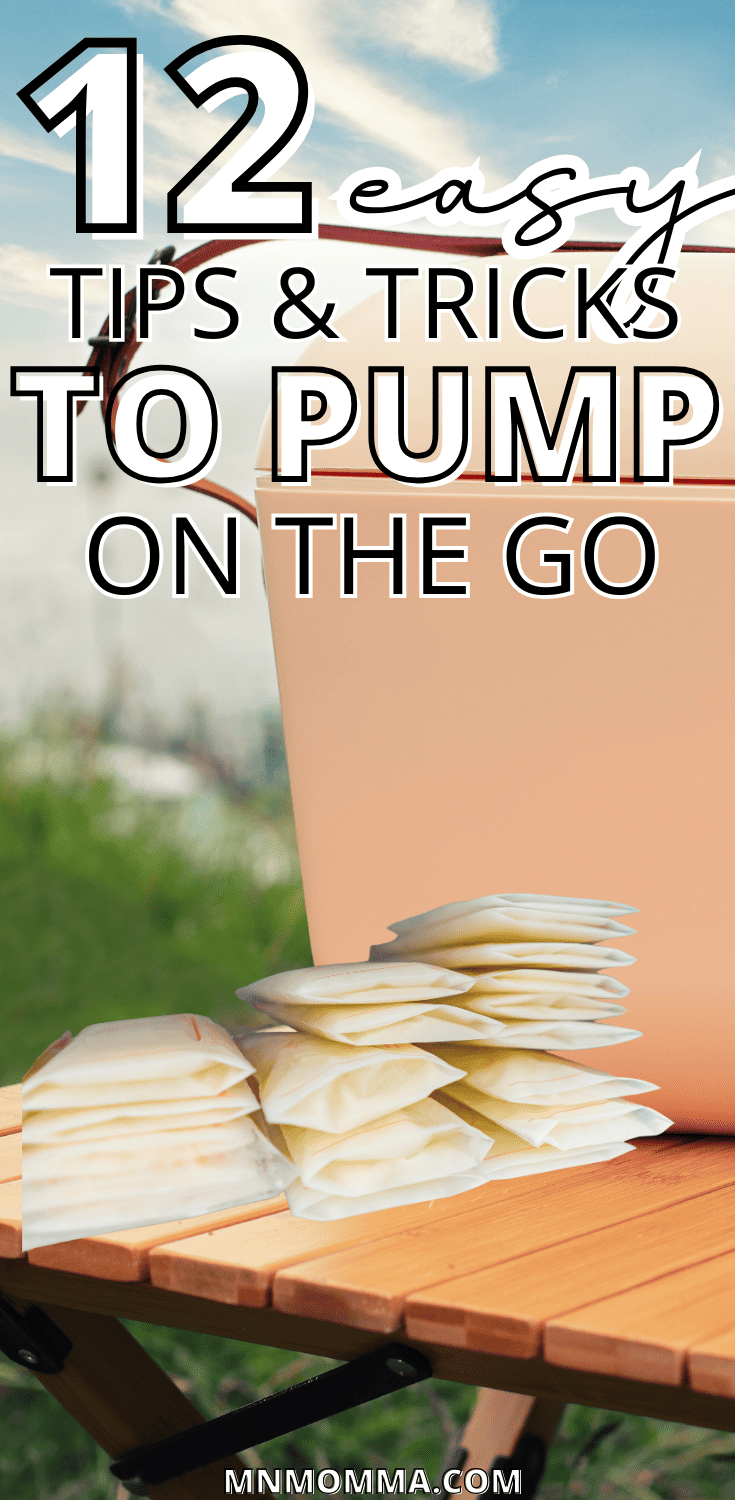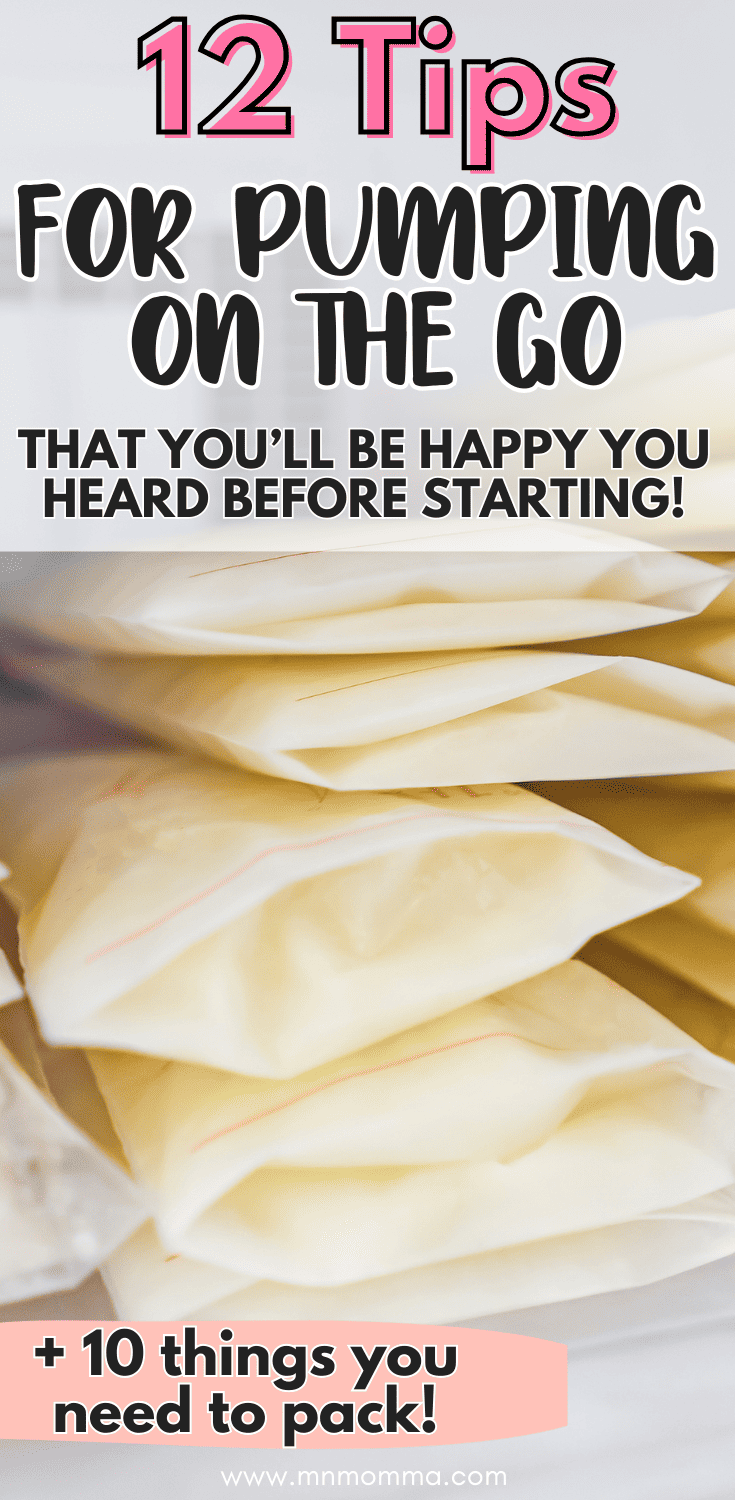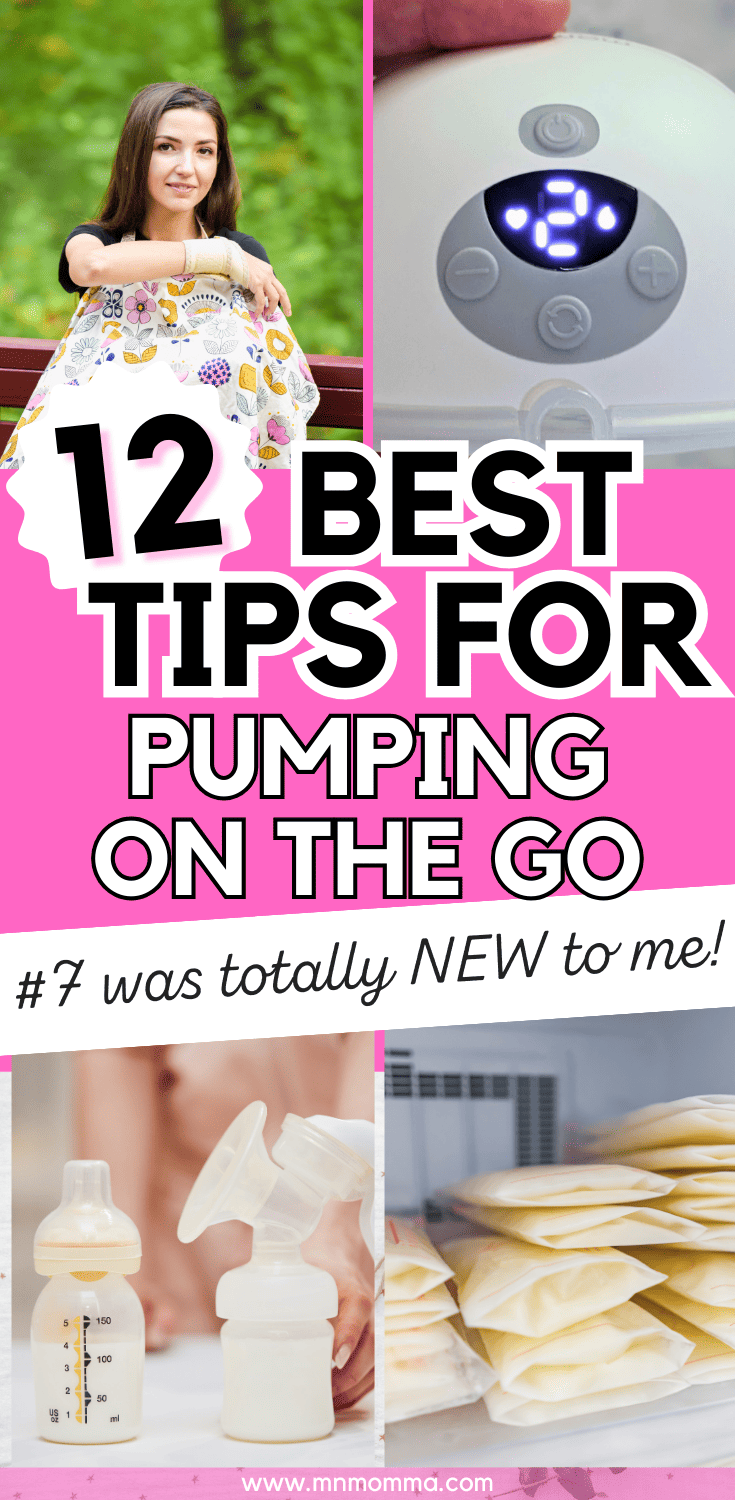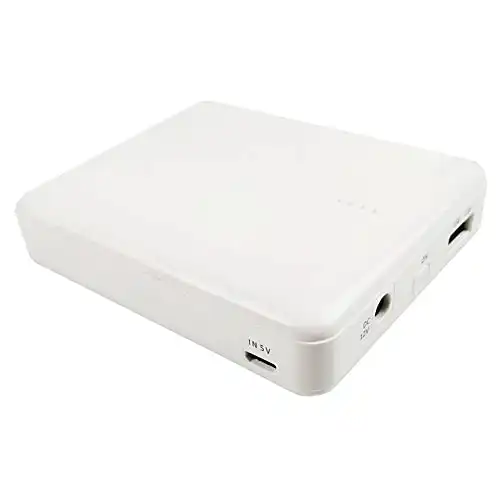12 Tips for Pumping on the Go (Busy Moms Ultimate Guide)
Disclosure: This post may contain affiliate links, which means I may receive a small commission if you click a link and purchase something. Please check out my disclosure policy for more details. All opinions are my own!
Whether you’re a first-time mom or a seasoned pro, there’s one thing we all have in common: the need to provide for our little ones.
For many of us, that means finding the best way to pump on the go while maintaining our busy lifestyles.
As a mom who’s pumped for three kids, I know what it’s like to feel like there’s not enough time in the day to fit in another pumping session.
Well, I’ve got some good news – pumping on the go can be a breeze with a little preparation and the right tools in your breast pump bag!

<— Pin it! Save this post for later!
12 Tips for Pumping on the Go
While multitasking might not be your favorite thing to be doing, there’s a mega sense of accomplishment in pumping for your new baby AND doing something else at the same time.
Here’s my best tips for busy moms who need to pump on the go:
1. Choose a Portable Pump
First things first, let’s talk about the star of the show – your breast pump.
While double electric breast pumps are fantastic for everyday use, they might not always be the best for traveling.
That’s where portable breast pumps come in!
These devices are a great option for pumping on the go.
A portable breast pump, like the Spectra S1, is a good idea for those quick pump sessions in a hotel room or when you need to discreetly pump in a lactation pod. Plus, it doesn’t require a power source, making it perfect for long road trips or flights.
Manual Breast Pumps come with a caveat.
The pros? They’re usually super small, super quiet, don’t need a power source, and are super easy to throw in your bag.
The cons, however, is that they take some work from you! Don’t think you’ll be driving and using a manual pump. These are best suited for situations where you can be alone and need to just get a quick session in.
2. Consider Wearable Pumps for Extra Convenience
Wearable breast pumps are a game-changer for busy moms.
I didn’t have one until my 3rd baby, and it was LIFE CHANGING.
If you have the ability, I highly recommend checking out a wearable pump, even some of the more affordable choices, as they offer hands-free pumping, allowing you to multitask while pumping.
You can easily slip them under your nursing cover or sweatshirt for privacy in public places or while on a long car ride.
3. Pack Smart
Create a checklist of the essential items you’ll need in your breast pump bag.
Here’s a quick checklist to be sure you’re not forgetting something important:
- Breast Pump & Parts
- Battery Pack or Rechargeable Battery
- Ice Packs and Cooler Bag
- Breast Milk Storage Bags and Bottles
- Diaper Bag with Wet Bag
- Disinfectant Wipes
- Ziploc Bags
4. Ensure Adequate Power
You’re going to be really upset if you pack everything you need to pump breast milk, only to find out that your pump doesn’t have the power it needs to actually pump.
I recommend you carry a rechargeable battery or extra power source for your electric pump to avoid running out of power during your trip.
5. Stay Organized
Pumping on the go is only half the battle.
After you pump breast milk, you’re going to need to do something with the milk.
Label and organize your pumped milk by date to ensure you use the oldest milk first and avoid any waste.
6. Use Ice Packs and Cooler Bags
After your breast milk is labeled and ready to be stored, keep it fresh stored safely by using ice packs and an insulated cooler bag to maintain the right temperature.
7. Use Milk Stork for Longer Trips
If you’re a working mom on the go or planning a long road trip, consider using Milk Stork.
It’s a service that helps you ship your pumped milk home so you don’t have to worry about milk storage while traveling.
8. Find a Private Space
Prioritize privacy by locating family restrooms, lactation rooms, or quiet corners when pumping in public places.
If you’re unsure about the cleanliness of a public bathroom, find a discreet spot in a family restroom.
9. Use Quick Cleaning Solutions
Amazingly enough, they now make special disinfectant wipes for wiping your pump parts down while on the go when you can’t get to a sink.
Carrying some disinfectant wipes for a quick clean can help keep your pump parts clean your breast milk safe for baby.
10. Bring Hot Water
Hot water is your friend for cleaning breast pump parts – if you’ll be somewhere that you can’t access hot water, bring a thermos of hot water for convenience.
You’ll be able to rinse and sterilize pump parts (if the water is boiling), especially when clean water sources are limited.
11. Use a Nursing Cover
When it comes to pumping on the go, privacy is a big deal.
Look for family restrooms, lactation rooms, or even use a nursing cover in a pinch (this is my favorite stretchy and breathable cover).
Remember, you’ve got the right to pump wherever you need to!
12. Label and Store Efficiently
Store extra pump parts in Ziploc bags, label everything clearly, and use breast milk storage bags or bottles for efficient milk storage.
These 12 tips will help you maintain your milk supply and make pumping on the go not so daunting.

What You Need To Pump On the Go
So what are the essential items you really need to pump on the go successfully?
1. A Portable Breast Pump
When you’re out and about, a full-sized electric breast pump might not be the most practical choice.
Opt for a portable or manual breast pump designed for travel.
These are smaller, lightweight, and easy to carry.
Top Pick: My favorites are the Baby Buddha (used with Legendairy Milk cups) or the MomCozy M5s or S12 Pro.
2. Extra Pump Parts
Always have spare pump parts on hand. You never know when a valve or membrane might wear out or get lost.
Having backups makes sure that you can continue to pump smoothly.
3. Rechargeable Battery or Power Source
If you’re using an electric pump, carry a rechargeable battery or a power source like a car adapter or a portable battery pack.
This way, you won’t find yourself without power during crucial pumping sessions.
4. Breast Milk Storage Bags or Bottles
We all know that storing your breast milk correctly is a big deal.
Make sure you pack breast milk storage bags or bottles, and label them with the date to ensure you use the oldest milk first.
Top Pick: These are my favorite storage bags. If you need to combine your milk into one container, I highly recommend the Ceres Chill.
5. Cooler Bag and Ice Packs OR Ceres Chill
Keep your pumped milk fresh by using an insulated cooler bag with ice packs.
This setup helps keep the milk’s temperature just right until you can refrigerate it.
Top Pick: The Ceres Chill is an amazing alternative to a cooler bag and ice packs.
6. Disinfectant Wipes
Keeping things clean while pumping on the go is super important.
I recommend you carry some disinfectant wipes to clean pump parts, surfaces, and your hands when soap and water aren’t readily available.
7. Ziploc Bags
Ziploc bags come in handy for storing small items like pump parts or used breast milk storage bags.
They’re also super easy to stash and travel with, just throw a few in your bag!
8. A Nursing Cover
When you’re a busy mom who moms on the go, you never know where you might end up needing to pump.
A nursing cover can give you some more discreet coverage, allowing you to pump with confidence almost anywhere you go.
9. Thermos with Hot Water (Optional)
Depending on where you’re going, you might need hot water to help clean your pump parts.
Consider bringing a thermos filled with hot water.
10. Storage Solutions
Finally, you need something to put all your pump stuff in.
I highly recommend investing in a great pump bag or at least bringing along bags or pouches to keep all your pumping supplies organized.

FAQ
Best Ways to Pump and Save Milk On the Go
After each pumping session, label and organize your pumped milk by date, using a cooler bag with ice packs to maintain its temperature until you can refrigerate it.
How to Keep Pump Parts Clean On the Go
Keeping your breast pump parts clean on the go is super important. The best way to do this is to follow these simple steps:
1. Wash Your Hands
Start by washing your hands with soap and clean water. If you don’t have access to a sink, use hand sanitizer or disinfectant wipes to clean your hands.
2. Use Clean Surfaces
Find a clean and stable surface to assemble and disassemble your pump parts. Carry disposable or portable sanitizing wipes to clean any surfaces that might not be clean.
3. Rinse Immediately
After each pumping session, rinse all pump parts that come into contact with breast milk. This helps remove any milk residue and prevents it from drying on the parts.
4. Store in a Sealable Bag
Place the rinsed pump parts in a clean, sealable bag, like a Ziploc bag or a wet bag. This keeps them from coming into contact with other items in your bag and prevents contamination.
5. Clean Properly Later
When you get home or to a place with access to clean water, wash the pump parts thoroughly with soap and hot water in a separate and dedicated container just for pump parts. Use a dedicated bottle brush or specialized cleaning brush to clean hard-to-reach areas.
Remember to let your pump parts dry completely before putting your pump back together – wet pump parts can increase the chance for mold and bacterial growth.
6. Sterilize When Possible
To ensure optimal cleanliness, consider sterilizing your pump parts regularly by boiling them or using a microwave sterilizer. Be sure to read your pump manual as well, as some pumps will recommend only sterilizing before your first pumping session.
For more info on how to properly clean your pump parts on the go, check out the CDC’s website.

What About the Fridge Hack?
Have you heard about the “fridge hack” on social media?
The fridge hack is where you don’t clean your pump parts between every use, but instead, place the parts (minus the pump) into the fridge until your next pumping session and then clean at the end of the day.
This is a somewhat touchy subject for some moms, so you’ll have to decide for yourself your level of risk tolerance and whether it’s best for your family.
The fridge hack is not supported by the CDC, but there are some reasons you might choice to do it or not do it – the Balanced Boob goes into more detail here.
If you decide you’re up for it, here’s how to do the fridge hack:
- Always start with clean hands
- Pump as normal
- Do not rinse with water before storing.
- Breast milk has immune components that reduce bacteria, and rinsing can increase the chance of bacterial growth.
- Put your pump parts into a container (like a ziplock bag or other storage container)
- Once you’re done for the day, wash your parts as normal with warm soapy water
What not to do:
- Don’t use the fridge hack for too long (not more than 8-12 hours)
- Don’t put your pump parts in the fridge door (this is where the temperature fluctuates most)
This fridge hack can save you time and effort, especially if you need to pump frequently throughout the day.
Remember to always prioritize cleanliness and follow any specific recommendations from your healthcare provider or lactation consultant.
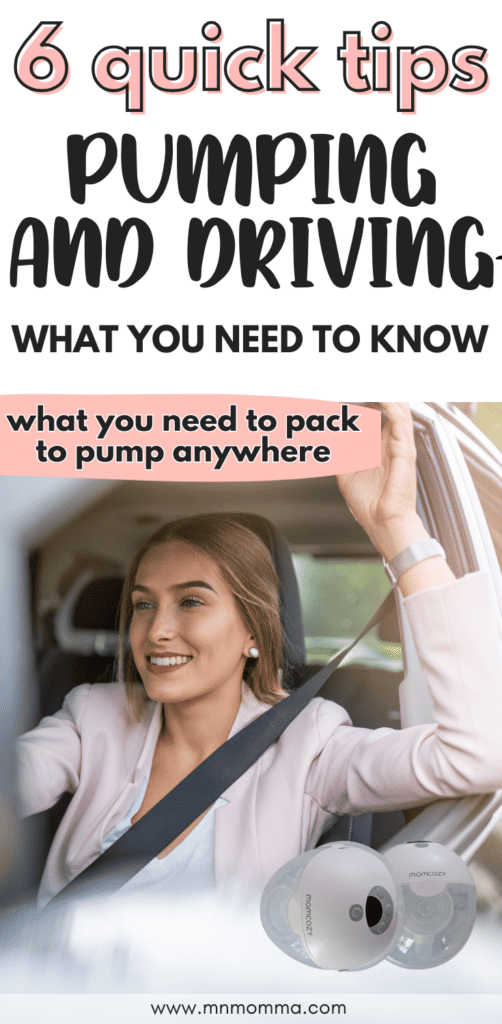
Can I Pump While Driving?
So what if you need to pump while driving?
If you can do it safely, you can pump while driving.
Try to follow these tips make your pumping while driving go as smoothly and safely as possible:
1. Use a Hands Free Pump
Invest in a hands-free breast pump like a wearable or double electric pump. These pumps have come a long way in recent years and allow you to pump without using your hands, which is essential for safe driving.
2. Get Setup Before You Go
Before putting the car in gear, be sure your pump is all set up. Tubing and flanges can get wonky once you position your seatbelt, so be sure everything is comfortable and nothing is kinked before you go.
3. Pull Over If you Need To
Remember that you and your passengers (and other drivers) safety is first priority. If you can’t focus on the road or your seatbelt isn’t sitting right, pull over and adjust things as needed – or stop pumping until you aren’t driving anymore.
4. Plan Your Drive
Plan your routes to include safe stops or rest areas where you can take breaks to pump if needed.
This way, you won’t feel rushed and can ensure a more relaxed pumping session.
5. Privacy
While most people probably won’t even notice you pumping while driving, it might make YOU feel kind of funny.
If you’re concerned about privacy, consider using a nursing cover or wearing a shawl or sweatshirt while pumping in the car.
6. Unhook When You’re Stopped
This may seem obvious, but don’t try to take your pump off or pour breast milk while you’re driving.
Wait until you’re parked to remove your pump and pour that liquid gold into bottles.
Remember that while pumping and driving can be a super convenient solution to getting your session in quickly, only do it if it can be done safely.
Check out more at Pumping While Driving and What You Really Need to Know.
The Best Tips and Tricks for Pumping on the Go
Pumping on the go may seem challenging, but with the right tools and some planning, it can be an efficient and enjoyable experience.
You won’t believe all the things you can do while pumping at the same time!
Related:
- Best Breastfeeding and Pumping Tips You Need to Know
- How to Start Using Power Pumping to Increase Supply
🎥 Check out the WebStory for 12 Tips for Pumping on the Go




